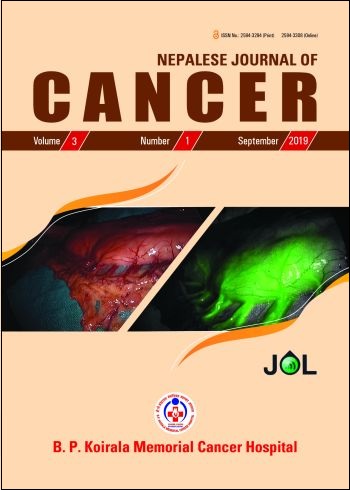A Retrospective Analysis of Carcinoma Penis Patients Treated at a Cancer Center in Nepal in a Period of Five Years
DOI:
https://doi.org/10.3126/njc.v3i1.25910Keywords:
Penile cancer, Inguinal lumph node, PenectomyAbstract
Introduction: Carcinoma Penis is not an uncommon condition in a developing country like Nepal and comprises 1-10% of all the malignancies in males. In this study we analyzed the demographic and clinicopathological profile of penile cancer patients who visited our cancer center during specified period.
Methods: This is a descriptive cross-sectional study, that altogether included 218 patients from January 2012 to December 2016 with penile cancer conducted at B P Koirala Memorial Cancer Hospital, Nepal. All the demographic and clinico-pathological data were collected and analyzed using SPSS 16.0 software. Tumor staging was standardized according to the American Joint Committee on Cancer system. Quantitative data were represented as mean and standard deviation whereas categorical variables were expressed as frequencies and percentages of an appropriate denominator.
Results: Among 218 patients, the mean ± SD age was 53.94 ± 13.69 years. Most were married (88.07%), smokers (67.88%), had poor personal hygiene (70.64%) and had not completed primary school (71.64%). The predominant profession was agriculture (81.65%). Most of the patients (56.88%) were diagnosed in clinical stage III b (T1-3, N2). Management was circumcision alone in 5.5%, Wide local excision in 6.88%, partial penectomy in 66.97% patients, total penectomy with perineal urethrostomy in 11% of patients and 9.63% patients were sent for chemotherapy after initial biopsy for fixed and fungating inguinal nodes. Bilateral inguinal lymph node dissection was performed in 87.15% patients. Most of our patients were uncircumcised (90.82%) Squamous cell carcinoma was the commonest histopathology (98.6%).
Conclusion: Penile cancer is more common among farmer with low socioeconomic status. The disease is already locally advanced and at the time of diagnosis. Surgery is the main modality of treatment.
Downloads
Downloads
Published
How to Cite
Issue
Section
License
This license lets others distribute, remix, tweak, and build upon your work, even commercially, as long as NJC and the authors are acknowledged.
Submission of the manuscript means that the authors agree to assign exclusive copyright to NJC. The aim of NJC is to increase the visibility and ease of use of open access scientific and scholarly articles thereby promoting their increased usage and impact.




